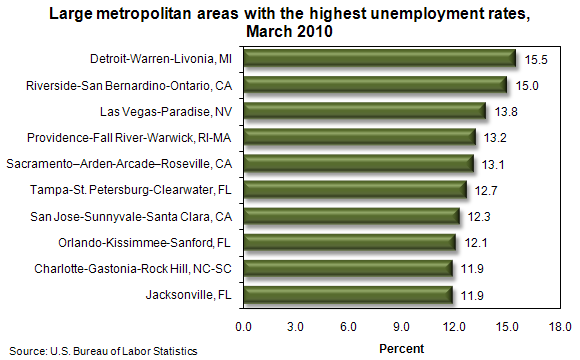April 30, 2010 (The Editor’s Desk is updated each business day.)
Unemployment in large metropolitan areas, March 2010
Of the 49 metropolitan areas with a Census 2000 population of 1 million or more, Detroit-Warren-Livonia, Michigan, and Riverside-San Bernardino-Ontario, California, reported the highest unemployment rates in March, 15.5 and 15.0 percent, respectively.

[Chart data]
Twenty additional large areas posted rates of 10.0 percent or more. The large areas with the lowest jobless rates in March were New Orleans-Metairie-Kenner, Louisiana, 6.0 percent; Oklahoma City, Oklahoma, 6.1 percent; and Washington-Arlington-Alexandria, D.C.-Virginia-Maryland-West Virginia, 6.7 percent.
From March 2009 to March 2010, forty-six of the large areas registered over-the-year unemployment rate increases, the largest of which occurred in Las Vegas-Paradise, Nevada (+3.2 percentage points). The next largest rate increases were recorded in Jacksonville, Florida (+2.9 percentage points), and Riverside-San Bernardino-Ontario, California (+2.7 points). Minneapolis-St. Paul-Bloomington, Minnesota-Wisconsin, and Buffalo-Niagara Falls, New York, were the only large areas to post jobless rate decreases over the year (‑0.6 and ‑0.2 percentage point, respectively).
These metropolitan area data are from the Local Area Unemployment Statistics program and are not seasonally adjusted. March 2010 metropolitan area unemployment rates are preliminary and subject to revision. Find out more in "Metropolitan Area Employment and Unemployment: March 2010" (HTML) (PDF), news release USDL-10-0534.
Related TED articles
Metropolitan areas and counties |
Unemployment
Of interest
Spotlight on Statistics: National Hispanic Heritage Month
In this Spotlight, we take a look at the Hispanic labor force—including labor force participation, employment and unemployment, educational attainment, geographic location, country of birth, earnings, consumer expenditures, time use, workplace injuries, and employment projections.
.
Read more »
